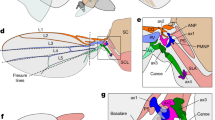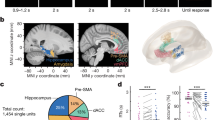Abstract
Entorhinal grid cells in mammals fire as a function of animal location, with spatially periodic response patterns. This nonlocal periodic representation of location, a local variable, is unlike other neural codes. There is no theoretical explanation for why such a code should exist. We examined how accurately the grid code with noisy neurons allows an ideal observer to estimate location and found this code to be a previously unknown type of population code with unprecedented robustness to noise. In particular, the representational accuracy attained by grid cells over the coding range was in a qualitatively different class from what is possible with observed sensory and motor population codes. We found that a simple neural network can effectively correct the grid code. To the best of our knowledge, these results are the first demonstration that the brain contains, and may exploit, powerful error-correcting codes for analog variables.
This is a preview of subscription content, access via your institution
Access options
Subscribe to this journal
Receive 12 print issues and online access
$209.00 per year
only $17.42 per issue
Buy this article
- Purchase on Springer Link
- Instant access to full article PDF
Prices may be subject to local taxes which are calculated during checkout




Similar content being viewed by others
References
Softky, W.R. & Koch, C. The highly irregular firing of cortical cells is inconsistent with temporal integration of random epsps. J. Neurosci. 13, 334–350 (1993).
Stevens, C.F. & Wang, Y. Changes in reliability of synaptic function as a mechanism for plasticity. Nature 371, 704–707 (1994).
Seung, H.S. Learning in spiking neural networks by reinforcement of stochastic synaptic transmission. Neuron 40, 1063–1073 (2003).
Kao, M.H., Doupe, A.J. & Brainard, M.S. Contributions of an avian basal ganglia-forebrain circuit to real-time modulation of song. Nature 433, 638–643 (2005).
Fiete, I.R. & Seung, H.S. Gradient learning in spiking neural networks by dynamic perturbation of conductances. Phys. Rev. Lett. 97, 048104 (2006).
Hubel, D. Eye, Brain and Vision (Scientific American Library, 1988).
Taube, J.S., Muller, R.U. & Ranck, J.B. Jr. Head-direction cells recorded from the postsubiculum in freely moving rats. I. Description and quantitative analysis. J. Neurosci. 10, 420–435 (1990).
O'Keefe, J. & Dostrovsky, J. The hippocampus as a spatial map: preliminary evidence from unit activity in the freely-moving rat. Brain Res. 34, 171–175 (1971).
Wilson, M.A. & McNaughton, B.L. Dynamics of the hippocampal ensemble code for space. Science 261, 1055–1058 (1993).
Schreiner, C.E., Read, H.L. & Sutter, M.L. Modular organization of frequency integration in primary auditory cortex. Annu. Rev. Neurosci. 23, 501–529 (2000).
Seung, H.S. & Sompolinsky, H. Simple models for reading neuronal population codes. Proc. Natl. Acad. Sci. USA 90, 10749–10753 (1993).
Abbott, L.F. & Dayan, P. The effect of correlated variability on the accuracy of a population code. Neural Comput. 11, 91–101 (1999).
Sompolinsky, H., Yoon, H., Kang, K. & Shamir, M. Population coding in neuronal systems with correlated noise. Phys. Rev. E 64, 051904 (2001).
Latham, P.E., Deneve, S. & Pouget, A. Optimal computation with attractor networks. J. Physiol. (Paris) 97, 683–694 (2003).
Brunel, N. & Nadal, J.-P. Mutualinformation, fisher information and population coding. Neural Comput. 10, 1731–1757 (1998).
Zhang, K. & Sejnowski, T. Neuronal tuning: to sharpen or broaden? Neural Comput. 11, 75–84 (1999).
Bethge, M., Rotermund, D. & Pawelzik, K. Optimal short-term population coding: when fisher information fails. Neural Comput. 14, 2317–2351 (2002).
MacKay, D. Information Theory, Inference and Learning Algorithms (Cambridge University Press, 2004).
Shannon, C. A mathematical theory of communication. Bell Syst. Tech. J. 27, 379–423 623–656 (1948).
Goblick, T. Theoretical limitations on the transmission of data from analog sources. IEEE Trans. Inf. Theory 11, 558–567 (1965).
Hafting, T., Fyhn, M., Molden, S., Moser, M.-B. & Moser, E. Microstructure of a spatial map in the entorhinal cortex. Nature 436, 801–806 (2005).
Fuhs, M.C. & Touretzky, D.S. A spin glass model of path integration in rat medial entorhinal cortex. J. Neurosci. 26, 4266–4276 (2006).
Burgess, N., Barry, C. & O'Keefe, J. An oscillatory interference model of grid cell firing. Hippocampus 17, 801–812 (2007).
Burak, Y. & Fiete, I.R. Accurate path integration in continuous attractor network models of grid cells. PLOS Comput. Biol. 5, e1000291 (2009).
Fiete, I.R., Burak, Y. & Brookings, T. What grid cells convey about rat location. J. Neurosci. 28, 6856–6871 (2008).
Deneve, S., Latham, P.E. & Pouget, A. Reading population codes: a neural implementation of ideal observers. Nat. Neurosci. 2, 740–745 (1999).
Zhang, K. Representation of spatial orientation by the intrinsic dynamics of the head-direction cell ensemble: a theory. J. Neurosci. 16, 2112–2126 (1996).
Tsodyks, M. Attractor neural network models of spatial maps in hippocampus. Hippocampus 9, 481–489 (1999).
Xie, X., Hahnloser, R.H.R. & Seung, H.S. Double-ring network model of the head-direction system. Phys. Rev. E 66, 041902 (2002).
Brun, V.H. et al. Impaired spatial representation in CA1 after lesion of direct input from entorhinal cortex. Neuron 57, 290–302 (2008).
Paradiso, M.A. A theory for the use of visual orientation information which exploits the columnar structure of striate cortex. Biol. Cybern. 58, 35–49 (1988).
Knierim, J.J., Kudrimoti, H.S. & McNaughton, B.L. Interactions between idiothetic cues and external landmarks in the control of place cells and head direction cells. J. Neurophysiol. 80, 425–446 (1998).
Lever, C., Burton, S., Jeewajee, A., O'Keefe, J. & Burgess, N. Boundary vector cells in the subiculum of the hippocampal formation. J. Neurosci. 29, 9771–9777 (2009).
Jin, D.Z. & Seung, H.S. Fast computation with spikes in a recurrent neural network. Phys. Rev. E. 65, 051922 (2002).
Shamir, M. The temporal winner-take-all readout. PLOS Comput. Biol. 5, e1000286 (2009).
Ma, W.J., Beck, J.M., Latham, P.E. & Pouget, A. Bayesian inference with probabilistic population codes. Nat. Neurosci. 9, 1432–1438 (2006).
Hanzo, L., Liew, T. & Yeap, B. Turbo Coding, Turbo Equalisation And Space-Time Coding (Wiley-IEEE Press, 2002).
Sudan, M. Ideal error-correcting codes: unifying algebraic and number-theoretic algorithms. in Applied Algebra, Algebraic Algorithms and Error-Correcting Codes (eds. Boztas, S. & Shparlinski, I.E.) 36–45 (Springer Berlin/Heidelberg, 2001).
Amaral, D.G. & Witter, M.P. The three-dimensional organization of the hippocampal formation: a review of anatomical data. Neuroscience 31, 571–591 (1989).
van Strien, N.M., Cappaert, N.L.M. & Witter, M.P. The anatomy of memory: an interactive overview of the parahippocampal-hippocampal network. Nat. Rev. Neurosci. 10, 272–282 (2009).
McNaughton, B.L., Barnes, C.A. & O'Keefe, J. The contributions of position, direction, and velocity to single unit activity in the hippocampus of freely-moving rats. Exp. Brain Res. 52, 41–49 (1983).
Remondes, M. & Schuman, E.M. Molecular mechanisms contributing to long-lasting synaptic plasticity at the temporoammonic-CA1 synapse. Learn. Mem. 10, 247–252 (2003).
Takahashi, H. & Magee, J.C. Pathway interactions and synaptic plasticity in the dendritic tuft regions of CA1 pyramidal neurons. Neuron 62, 102–111 (2009).
Carr, M.F., Jadhav, S.P. & Frank, L.M. Hippocampal replay in the awake state: a potential substrate for memory consolidation and retrieval. Nat. Neurosci. 14, 147–153 (2011).
Burgess, N. Grid cells and theta as oscillatory interference: theory and predictions. Hippocampus 18, 1157–1174 (2008).
Hafting, T., Fyhn, M., Bonnevie, T., Moser, M. & Moser, E. Hippocampus-independent phase precession in entorhinal grid cells. Nature 453, 1248–1252 (2008).
Ahmed, O.J. & Mehta, M.R. The hippocampal rate code: anatomy, physiology and theory. Trends Neurosci. 32, 329–338 (2009).
Jarsky, T., Roxin, A., Kath, W.L. & Spruston, N. Conditional dendritic spike propagation following distal synaptic activation of hippocampal ca1 pyramidal neurons. Nat. Neurosci. 8, 1667–1676 (2005).
Ang, C.W., Carlson, G.C. & Coulter, D.A. Hippocampal CA1 circuitry dynamically gates direct cortical inputs preferentially at theta frequencies. J. Neurosci. 25, 9567–9580 (2005).
Ristic, B., Arulampalam, S. & Gordon, N. Beyond the Kalman Filter: Particle Filters for Tracking Applications (Artech House Radar Library, 2004).
Acknowledgements
We are grateful to Y. Burak, S. Seung, A. Kepecs, P. Latham, A. Pouget and P. Dayan for thought-provoking questions and comments, S.H. Lee for helpful conversations, T. Lam for advice on a volume computation, D. Johnston, A. Huk, N. Priebe, A. Tan and members of our laboratory for comments on the manuscript, and A. Preston for useful pointers to the literature. I.F. is a Sloan Foundation Fellow, a Searle Scholar and a McKnight Scholar, and receives funding from the Office of Naval Research through the Multidisciplinary University Research Initiative.
Author information
Authors and Affiliations
Contributions
I.F. conceived the model. S.S. performed simulations and analyzed the data. I.F. and S.S. performed analytical calculations and wrote the manuscript.
Corresponding author
Ethics declarations
Competing interests
The authors declare no competing financial interests.
Supplementary information
Supplementary Text and Figures
Supplementary Results (PDF 909 kb)
Rights and permissions
About this article
Cite this article
Sreenivasan, S., Fiete, I. Grid cells generate an analog error-correcting code for singularly precise neural computation. Nat Neurosci 14, 1330–1337 (2011). https://doi.org/10.1038/nn.2901
Received:
Accepted:
Published:
Issue Date:
DOI: https://doi.org/10.1038/nn.2901
This article is cited by
-
Attractor and integrator networks in the brain
Nature Reviews Neuroscience (2022)
-
How to build a cognitive map
Nature Neuroscience (2022)
-
Remapping and realignment in the human hippocampal formation predict context-dependent spatial behavior
Nature Neuroscience (2021)
-
Bio-inspired multi-scale fusion
Biological Cybernetics (2020)
-
Goal-directed navigation based on path integration and decoding of grid cells in an artificial neural network
Natural Computing (2019)



